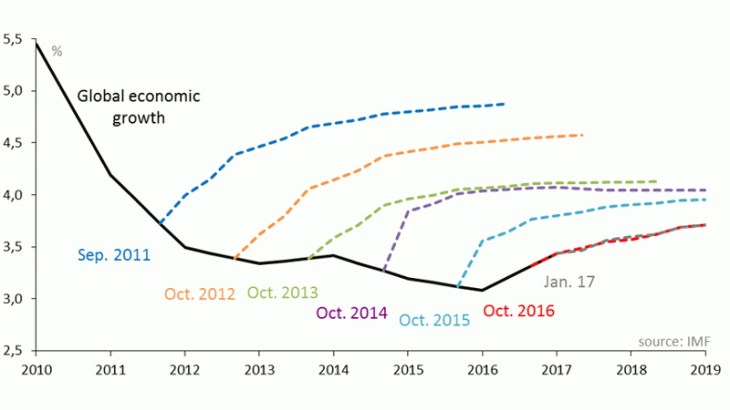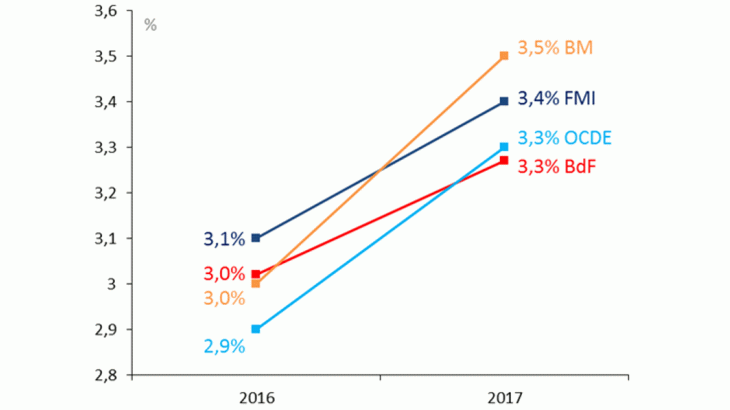The January 2017 update of the IMF World Economic Outlook (WEO) forecasts an acceleration in global economic activity in 2017, thereby confirming its October assessment. This has been a first since 2011. In the years since the so-called “Great Recession”, the IMF has had to systematically revise downwards its global economic growth projections (see Figure 1).
As regards 2017, global growth projections by the IMF can be traced back to the April 2012 WEO. At that date, world GDP growth was forecast at 4.7%; it is now at 3.4% in the latest 2017 update. This 1.3 percent point fall can be mainly explained by the slowdown in emerging market economies. Thus, the IMF has cut the 2017 economic projection of emerging economies by 2.3 percent points between 2012 and 2017 (from 6.8% to 4.5%). To a lesser extent the estimated 1.9% economic growth of advanced countries for 2017 is also below original expectations of 2.4% in 2012.
An optimistic bias since the Great Recession
Persistent over-optimism about regional and global growth is not specific to IMF forecasts. Growth projections by international and national economic institutions have also followed similar patterns since the Great Recession. How to explain this optimistic bias?
First, emerging countries have experienced important changes in their growth models. It is well known by economists that such “new normal” paradigm can only be progressively integrated into forecasting models. In particular, China, which now represents about 17% of global output, has entered a new phase of economic development, shifting from a strong export orientation to a consumer-driven economy. This rebalancing has had negative effects on China’s domestic GDP growth, falling from 10.3% in 2010 to 6.5% in 2017, according to IMF estimates.
Second, other structural and cyclical headwinds contributed to the lack of robust momentum in the global economy. These include some well-documented factors such as weak economic growth in the euro area, the global trade slowdown, the slump in business investment, increased geopolitical risks and declining commodity prices.
Our nowcasting model confirms a pick-up in 2017 global growth
How confident can we be about the forecasts of growth resurgence in 2017? Growing uncertainty surrounding baseline assumptions has weakened global projection exercises, requiring the analysis of low-probability economic scenarios. In this context, nowcasting models appear as interesting alternatives. Nowcasting --a contraction of “now” and “forecasting”-- attempts to assess economic growth in real time by estimating the impact of newly-released data on contemporaneous projections.
A Banque de France Working Paper (Ferrara and Marsilli, 2014; see also Rue de la Banque) puts forward a new nowcasting tool that tracks in real-time annual global economic growth on a monthly basis. Using a large data-set of both national and global economic indicators, the model assesses monthly world economic dynamics and estimates the implications for global growth in the current year. Regular updates provide early estimates (nowcasts) of the global activity which tend to anticipate IMF global growth revisions.

